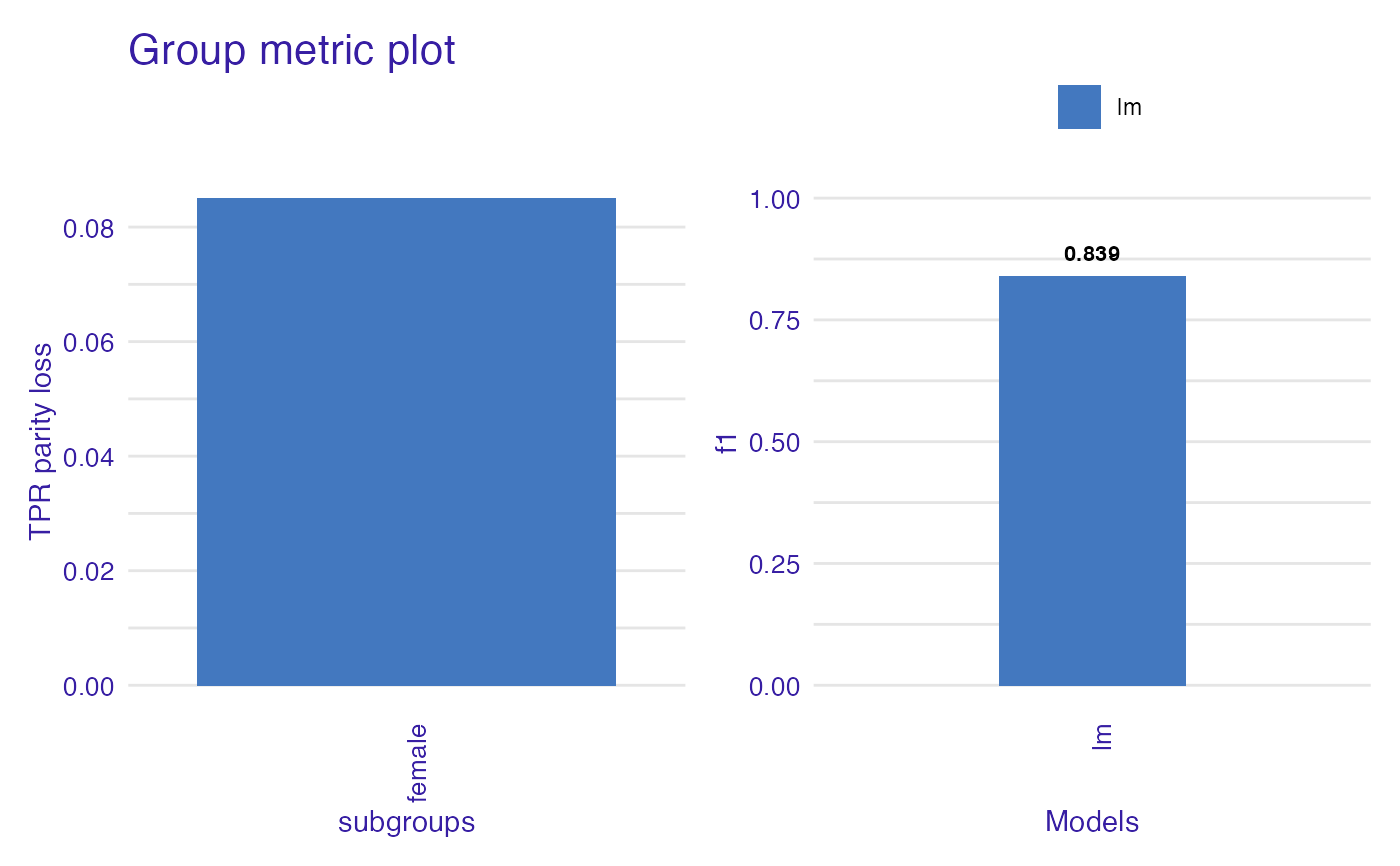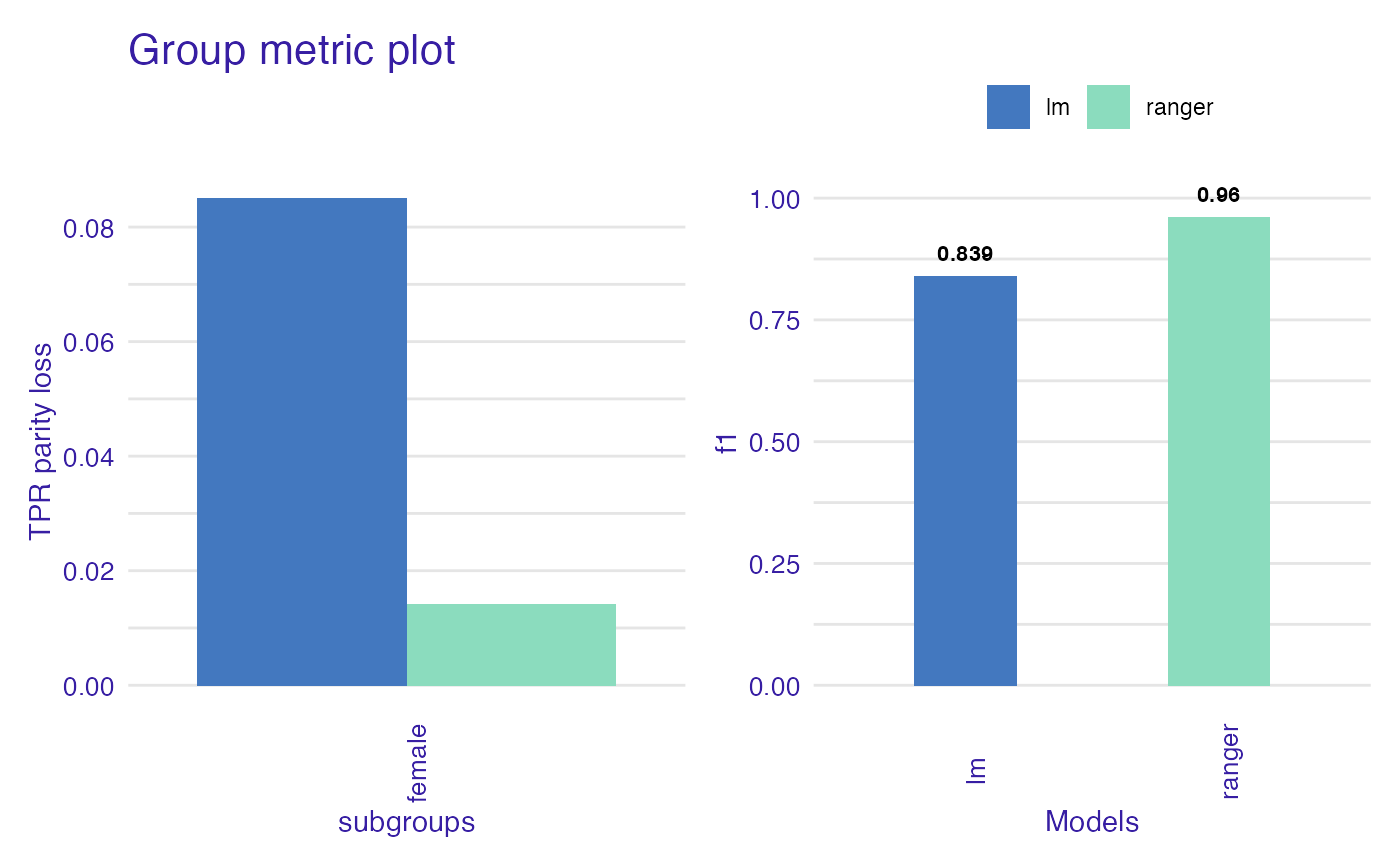Group metric enables to extract data from metrics generated for each subgroup (values in protected variable)
The closer metric values are to each other, the less bias particular model has. If parity_loss parameter is set to TRUE, distance between
privileged and unprivileged subgroups will be measured. When plotted shows both fairness metric and chosen performance metric.
group_metric(
x,
fairness_metric = NULL,
performance_metric = NULL,
parity_loss = FALSE,
verbose = TRUE
)Arguments
| x | object of class |
|---|---|
| fairness_metric | character, fairness metric name, if |
| performance_metric | character, performance metric name |
| parity_loss | logical, if |
| verbose | logical, whether to print information about metrics on console or not. Default |
Value
group_metric object.
It is a list with following items:
group_metric_data -
data.framecontaining fairness metric scores for each modelperformance_data -
data.framecontaining performance metric scores for each modelfairness_metric - name of fairness metric
performance_metric - name of performance metric
Details
Available metrics:
Fairness metrics (Full names explained in fairness_check documentation):
TPR
TNR
PPV
NPV
FNR
FPR
FDR
FOR
TS
ACC
STP
F1
Performance metrics
recall
precision
accuracy
f1
auc
Examples
data("german")
y_numeric <- as.numeric(german$Risk) - 1
lm_model <- glm(Risk ~ .,
data = german,
family = binomial(link = "logit")
)
explainer_lm <- DALEX::explain(lm_model, data = german[, -1], y = y_numeric)
#> Preparation of a new explainer is initiated
#> -> model label : lm ( default )
#> -> data : 1000 rows 9 cols
#> -> target variable : 1000 values
#> -> predict function : yhat.glm will be used ( default )
#> -> predicted values : No value for predict function target column. ( default )
#> -> model_info : package stats , ver. 4.1.1 , task classification ( default )
#> -> predicted values : numerical, min = 0.1369187 , mean = 0.7 , max = 0.9832426
#> -> residual function : difference between y and yhat ( default )
#> -> residuals : numerical, min = -0.9572803 , mean = 1.940006e-17 , max = 0.8283475
#> A new explainer has been created!
fobject <- fairness_check(explainer_lm,
protected = german$Sex,
privileged = "male"
)
#> Creating fairness classification object
#> -> Privileged subgroup : character ( Ok )
#> -> Protected variable : factor ( Ok )
#> -> Cutoff values for explainers : 0.5 ( for all subgroups )
#> -> Fairness objects : 0 objects
#> -> Checking explainers : 1 in total ( compatible )
#> -> Metric calculation : 13/13 metrics calculated for all models
#> Fairness object created succesfully
gm <- group_metric(fobject, "TPR", "f1", parity_loss = TRUE)
#>
#> Creating object with:
#> Fairness metric: TPR
#> Performance metric: f1
#>
plot(gm)
 # \donttest{
rf_model <- ranger::ranger(Risk ~ .,
data = german,
probability = TRUE,
num.trees = 200
)
explainer_rf <- DALEX::explain(rf_model, data = german[, -1], y = y_numeric)
#> Preparation of a new explainer is initiated
#> -> model label : ranger ( default )
#> -> data : 1000 rows 9 cols
#> -> target variable : 1000 values
#> -> predict function : yhat.ranger will be used ( default )
#> -> predicted values : No value for predict function target column. ( default )
#> -> model_info : package ranger , ver. 0.13.1 , task classification ( default )
#> -> predicted values : numerical, min = 0.07845238 , mean = 0.6954966 , max = 0.9985714
#> -> residual function : difference between y and yhat ( default )
#> -> residuals : numerical, min = -0.7493194 , mean = 0.004503438 , max = 0.6740554
#> A new explainer has been created!
fobject <- fairness_check(explainer_rf, fobject)
#> Creating fairness classification object
#> -> Privileged subgroup : character ( from first fairness object )
#> -> Protected variable : factor ( from first fairness object )
#> -> Cutoff values for explainers : 0.5 ( for all subgroups )
#> -> Fairness objects : 1 object ( compatible )
#> -> Checking explainers : 2 in total ( compatible )
#> -> Metric calculation : 10/13 metrics calculated for all models ( 3 NA created )
#> Fairness object created succesfully
gm <- group_metric(fobject, "TPR", "f1", parity_loss = TRUE)
#>
#> Creating object with:
#> Fairness metric: TPR
#> Performance metric: f1
#>
plot(gm)
# \donttest{
rf_model <- ranger::ranger(Risk ~ .,
data = german,
probability = TRUE,
num.trees = 200
)
explainer_rf <- DALEX::explain(rf_model, data = german[, -1], y = y_numeric)
#> Preparation of a new explainer is initiated
#> -> model label : ranger ( default )
#> -> data : 1000 rows 9 cols
#> -> target variable : 1000 values
#> -> predict function : yhat.ranger will be used ( default )
#> -> predicted values : No value for predict function target column. ( default )
#> -> model_info : package ranger , ver. 0.13.1 , task classification ( default )
#> -> predicted values : numerical, min = 0.07845238 , mean = 0.6954966 , max = 0.9985714
#> -> residual function : difference between y and yhat ( default )
#> -> residuals : numerical, min = -0.7493194 , mean = 0.004503438 , max = 0.6740554
#> A new explainer has been created!
fobject <- fairness_check(explainer_rf, fobject)
#> Creating fairness classification object
#> -> Privileged subgroup : character ( from first fairness object )
#> -> Protected variable : factor ( from first fairness object )
#> -> Cutoff values for explainers : 0.5 ( for all subgroups )
#> -> Fairness objects : 1 object ( compatible )
#> -> Checking explainers : 2 in total ( compatible )
#> -> Metric calculation : 10/13 metrics calculated for all models ( 3 NA created )
#> Fairness object created succesfully
gm <- group_metric(fobject, "TPR", "f1", parity_loss = TRUE)
#>
#> Creating object with:
#> Fairness metric: TPR
#> Performance metric: f1
#>
plot(gm)
 # }
# }